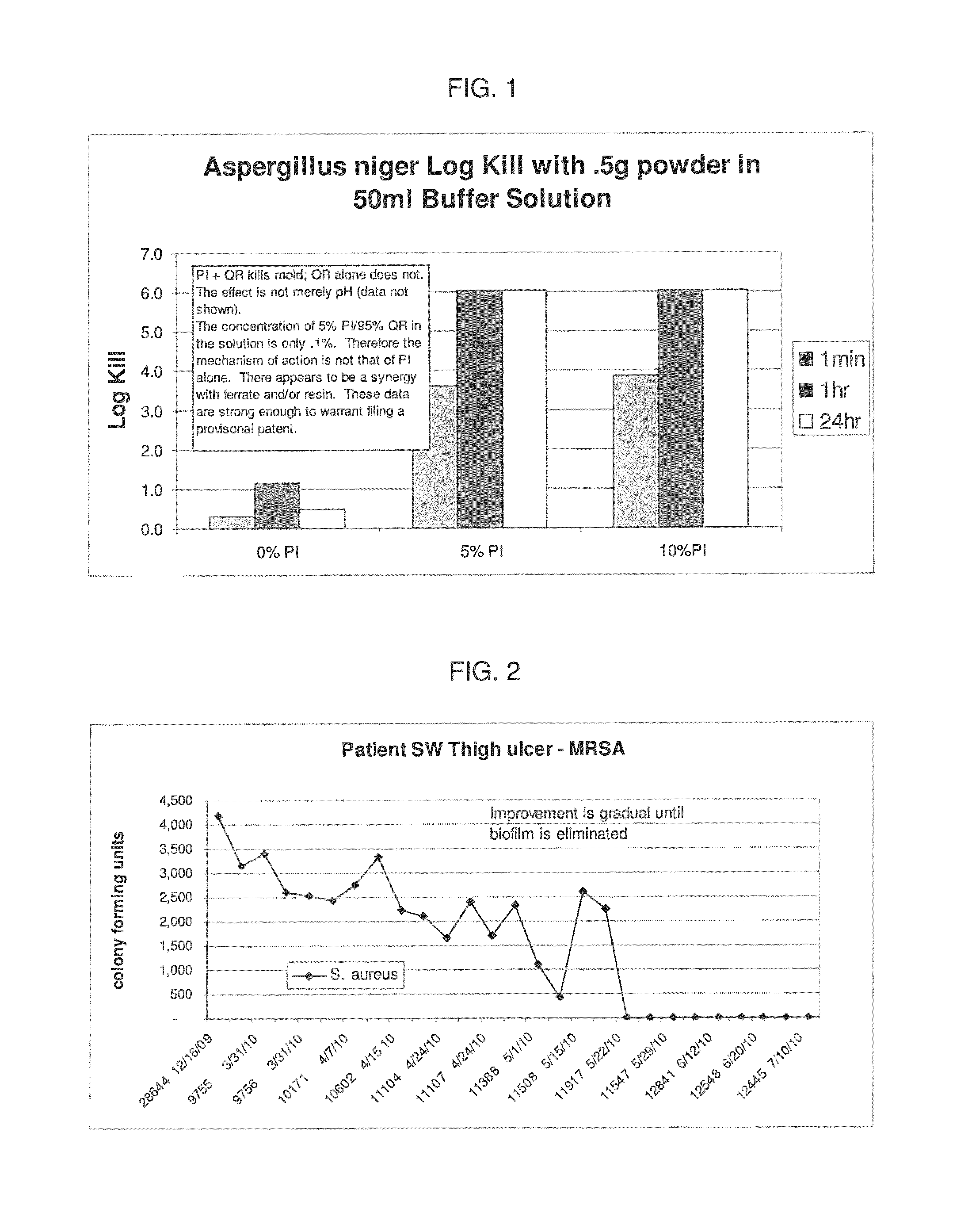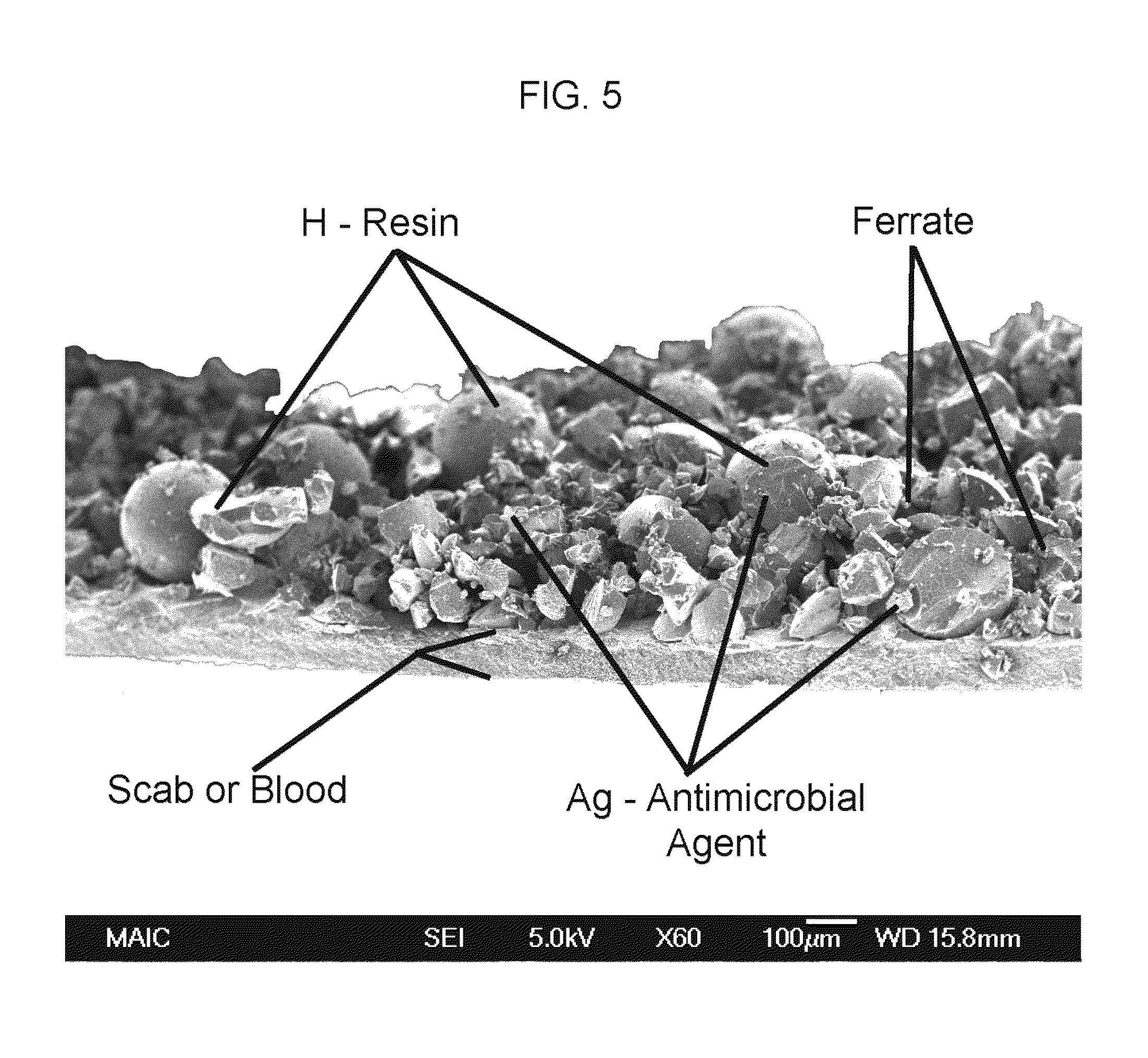Ferrate and povidone iodine (PI) composition
a technology of ferrate and povidone, applied in the field of hemostatic and antimicrobial barrier composition, can solve the problems of not being able to apply to active bleeding sites, messy ointments, and washing of ointments, so as to prevent desiccation of wounds, prevent maceration, and facilitate wound healing
- Summary
- Abstract
- Description
- Claims
- Application Information
AI Technical Summary
Benefits of technology
Problems solved by technology
Method used
Image
Examples
example 1
Explanation of Example 1
[0081]Experts describe the resilience of in-vivo biofilms versus in-vitro antimicrobial testing as almost three orders of magnitude greater in a biofilm than as planktonic bacteria. Thus, an in-vitro test demonstrates efficacy that does not translate to efficacy in practice. MRSA is easier to kill than Pseudomonas in mature biofilms in-vivo. The iodine had to be increased all the way to 10% before Pseudomonas was killed.
[0082]The powder is packed into the wound such that the proximal side is damp and the distal side is dry. Dry PI does not release I2 to the wound site. Thus, as the powder gets increasingly damp, there is a slow release of I2. More iodine is not more lethal. In fact, iodine is most lethal at very low levels. What iodine leaching from damp powder does is extend the time that lethal low levels of iodine are exposed to the biofilm.
[0083]The ferrate dissolves in exudate and releases a free Fe3+. The iron displaces the calcium reinforcing the EPS, ...
example 2
Explanation of Example 2
[0086]Fe3+ regenerates iodine from iodide and converts into Fe2+ as shown above. Fe4+ does not have this reaction. Thus, the ferrate is a source of soluble Fe3+, increasing the net duration of free iodine availability. With extended free iodine availability, pseudomonas is destroyed. What is surprising is that an indirect source of soluble Fe3+, a divalent cation sequestering agent (resin, poly phosphate, fatty acid etc) and a source of free iodine (I2) and iodide (I−) can disrupt, disperse and destroy multi-drug resistant biofilms in vivo.
Example 3
[0087]Patient WU has a venous ulcer that required debriding of biofilm three times per week, but the wound still did not heal. She was treated with the ferrate / resin / 10% API powder. Biopsies and detailed analysis of the wound bed demonstrated a statistically significant reduction in biofilm with the powder versus sharp debridement.
[0088]A sample of the biofilm was extracted from WU and transferred to a 96 count pla...
example 3
Explanation of Example 3
[0089]WU is a patient at a medical college wound clinic. With informed consent, WU was treated in vivo, but her biofilm was captured and grown into biofilm in a controlled reproducible fashion. The in vitro work is a work in progress as of this filing. The work is intended to elucidate the exact mechanism of action postulated elsewhere in this specification. Even at this early date, the work confirms the clinical in vivo findings.
Example 4
[0090]A mixture of various iron sources, chelation compounds, and active antimicrobials was tested using the recovered biofilm from WU according to the matrix in Table III.
[0091]
TABLE IIIHemo-BiofilmstasisEradica-IronActiveRatingtionSourceChelatorAntiseptic (1-10)(1-10) 1Fe2O3tripoly phosphate10% PI27 2Fe2O3stearic acid10% PI14 3Fe2O3EDTA10% PI48 4Fe2O3cation exchange10% PI69resin 5Fe2O3tripoly phosphatebenzethonium17chloride 6Fe2O3stearic acidbenzethonium24chloride 7Fe2O3EDTAbenzethonium56chloride 8Fe2O3cation exchangebenze...
PUM
| Property | Measurement | Unit |
|---|---|---|
| pH | aaaaa | aaaaa |
| pH | aaaaa | aaaaa |
| scanning electron microscope | aaaaa | aaaaa |
Abstract
Description
Claims
Application Information
 Login to View More
Login to View More - R&D
- Intellectual Property
- Life Sciences
- Materials
- Tech Scout
- Unparalleled Data Quality
- Higher Quality Content
- 60% Fewer Hallucinations
Browse by: Latest US Patents, China's latest patents, Technical Efficacy Thesaurus, Application Domain, Technology Topic, Popular Technical Reports.
© 2025 PatSnap. All rights reserved.Legal|Privacy policy|Modern Slavery Act Transparency Statement|Sitemap|About US| Contact US: help@patsnap.com



